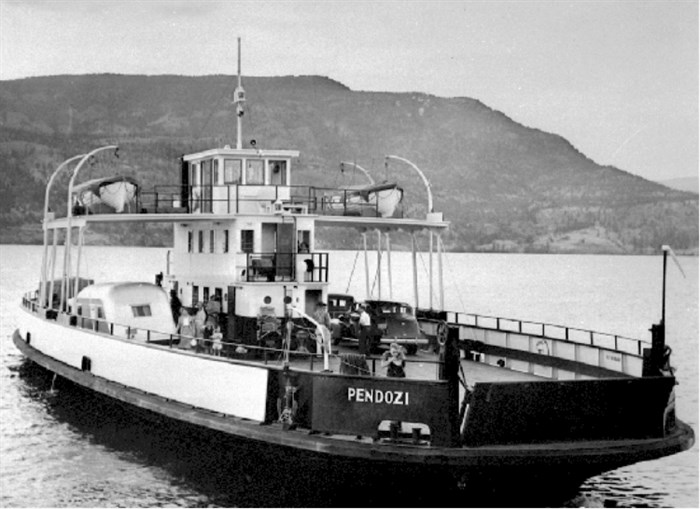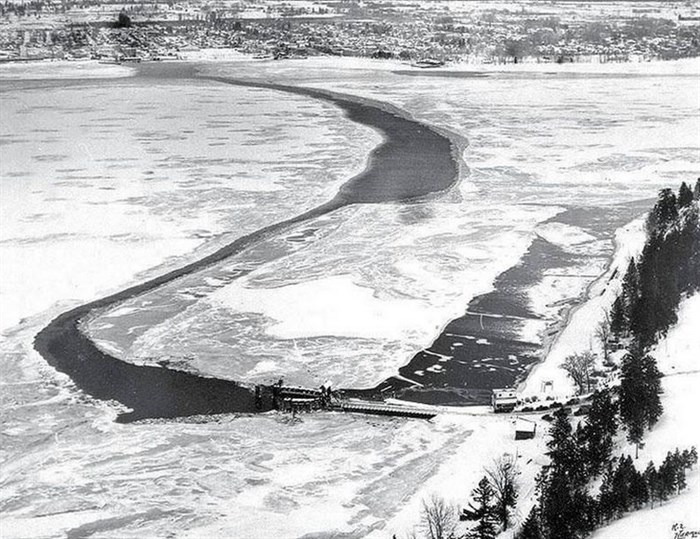
The MV Pendozi – a misspelling of Father Pandosy – was one of three government-run ferries plying the Narrows between Kelowna and Westbank.
Image Credit: Submitted/lakecountrymuseum.com
January 02, 2021 - 11:57 AM
Travellers through the Okanagan may whine about the traffic crawling over the William R. Bennett Bridge, especially at rush hour.
But there was a time, before the first floating bridge was opened in 1958, when boats were needed to make the crossing and delays could be somewhat longer.
“One of the big things we’ve missed – and a lot of us old timers have spoken about this – we miss the restful times we had sitting there looking at the scenery as we went over and catching up on our reading,” Ferne Jean told iNFOnews.ca.
That was back when the ferries ran once an hour for the 13 minute crossing. It wasn’t that they had to wait for hours since they always knew the best times to get on, but it was still a slower time.
For her friend Merle Griffin, the ferry meant she could be dropped off at the Westbank beach next to the ferry dock to go for a swim while her parents went across to town.
On the other hand, Jean noted, it was advisable for a pregnant woman to make the crossing a few days before her due date to make sure she didn’t get stuck on the wrong side of the lake when the time came.
Of course, the need to get across the “narrows” between Kelowna and Westbank, long predated even the government-funded ferries.
The first recorded crossing of Okanagan Lake by boat seems to have been in 1885.
“The Palmer and Miller expedition set out from Walla Walla, Washington with nine wagons loaded with miner’s supplies destined for Port Kamloops,” R. Bruce Goett wrote in Lake Boats of the Okanagan, a report posted on the Lake Country Museum website.
“In order to cross Okanagan Lake, the wagons were dismantled and loaded onto 50 rafts along with the supplies. The horses and oxen then had to be herded back to Penticton and through the east side trail and Wild Horse Canyon, and on to Mission Creek where they met up with the wagons.”
There was also a gold rush at Granite Creek, in the Tulameen region west of the Okanagan, that year with miners buying supplies in Kelowna and needing to ferry them across the lake.
"Eneas and David McDougall placed a scow on the lake in the same year,” Goett wrote. “Their vessel, which was 16 feet long and 10 or 12 feet wide depended on the rowing ability of its passengers for its motive power. Its capacity was three heavy horses or five pack horses.
“This first ferry was not outstanding for its efficiency of service, and after the Granite Creek rush died out, it was used only occasionally. When a person seeking passage arrived on the west side, he first had to find the trail to Eneas’ house which was four miles away. If McDougall happened to be away, which was often the case, the traveller had to swim his horse across the lake. This was accomplished simply enough by two people and a rowboat, one rowing, the other holding a rope tied to the horse.”
But it wasn’t until April 1, 1906 that a regular ferry service was established when a $1,000 per year subsidy was offered to provide two round trips a day, weather permitting, except Sundays.
“H.B.D. Lysons won the contract and built the ‘Skookum,’ also known as the ‘Tut—tut’ which was 30 feet long and powered by a one cylinder, seven horsepower Truscott engine, and a scow measuring 40 feet by 16 feet,” Goett wrote.
He was bought out by L.A. Hayman the next year who, in 1924, had one of most exciting crossings on record.
“Len Hayman, one of Kelowna’s legendary and more colourful characters, captained a succession of ferries across Okanagan Lake,” Sharron Simpson wrote in her book, The Kelowna Story.
“The Aricia was one of the more substantial at twelve-and-a-half tons and was equipped with a passenger cabin, a pilot house and, uniquely, a lifeboat. When demand increased and included cars, Hayman added a scow that could carry up to eight vehicles.
“Though he was well experienced, he still ran into trouble on the unpredictable lake. On one memorable trip, the captain cast off from Kelowna into a stiff wind with six cars and nineteen passengers. All was well until he was just about to pull into the Westbank wharf and was broadsided by a swift gale from the north. Even with the engine at full throttle, there was little Hayman could do: he cast off the scow and its cargo of automobiles and then fought to keep the boat away from the rocks. The scow bounced off the boulders and disappeared into the lake.
“The passenger boat, however, hit the rocks and stuck fast. Waves washed over the stern, the lifeboat filled with water, and then the gas line broke and the passengers were being gassed. They panicked. Hayman threatened to throw them all overboard if they didn’t shut up and behave properly and he finally managed to lower the lifeboat, bail it out and take the passengers to shore.
“One of the few who had managed to maintain his composure was dispatched to the dock to telephone one of the captain’s friends in Kelowna with orders to bring over another boat. When the friend arrived the pair headed down the lake to collect the scow. Even with the drama, all passengers and cars were delivered to the Westbank dock only an hour and a half later than their scheduled arrival time.”
In 1927, the provincial government took over the ferry service and launched the MV Kelowna-Westbank with the capacity to carry 15 cars.
“It wasn’t long before the boat became known as the MV Hold-up because the service was so bad,” Simpson wrote.
In the winter, the lake often froze over. Efforts were made to keep channels open for the ferries but they didn't always succeed.
“People walked if they wanted to cross the lake, or found a horse and sleigh or perhaps a motorcycle and sidecar to carry them to the other side,” Simpson wrote.

The winter of 1949-50 was one of the coldest on record and the last time Okanagan Lake froze over from end to end, according to this 2014 posting on the Old Kelowna Facebook page. The wide spot allowed two ferries to operate at the same time.
Image Credit: FACEBOOK/Oldkelowna:
Not being able to keep up with demand, that MV Kelowna-Westbank was replaced in 1939 by the MV Pendozi with its 30-car capacity. Shortly after, the old ferry was inspected and condemned.
As demand continued to increase, the MV Lloyd-Jones was added on May 1, 1946 and the MV Lequime in July 1950, Goett wrote.
By then, he wrote, the ferries were running an annual deficit of $250,000 and could not handle the traffic so the Okanagan Lake bridge was built and completed in 1958.
An article posted on the Lake Country Museum’s web site and attributed to the West Kelowna Yacht Club said the three ferries carried 534,371 vehicles in their last year of service.
Simpson portrayed the need for a bridge in a slightly different light.
“With the arrival of the Cold War of the 1950s and related talk of World War III a bridge across Okanagan Lake was seen as a ‘missing link’ in the free flow of traffic between California and the Alaska Highway,” she wrote.
Okanagan Lake Bridge was officially opened by Princess Margaret on July 17, 1958 with the MV Lloyd-Jones taking an honourary sail through the raised lift span later that day, marking the end of the ferry era on Okanagan Lake.
READ MORE: Why the Okanagan Lake bridge has to float
The ferries, no longer being needed, were sent off in separate directions.
The oldest, the MV Pendozi sank at the C.N. wharf in Kelowna on New Year’s Day in 1965. The recently-formed Westbank Yacht Club convinced the City of Kelowna to donate the raised vessel to serve as their clubhouse, according to the club’s website.
The MV Lequime was redesigned with a paddlewheel and renamed the Fintry Queen to “transport travelers and tourist to the new development of Fintry Estates,” states the Fintry Queen website.
It sailed for a number of years as a tour boat but the latest information has it docked it the north end of Okanagan Lake.
The most recent posting on the MV Fintry Queen Facebook page was Sept. 18, 2018 saying promoters were heading to the Penticton Farmers' Market “signing up supporters and asking for comments in support of our plan to build landings in Penticton, Naramata and Summerland.”
The hope was to operate in the summer of 2019.
The newest ferry, the MV Lloyd-Jones, was moved by B.C. Ferries to run from Vesuvius on Salt Spring Island to Crofton on Vancouver Island, according to a Lake Country Museum posting.
It was sold and moved to the Dominican Republic in 1998, according to the Fintry Queen website.
— This story was originally published Sept. 6, 2020.
To contact a reporter for this story, email Rob Munro or call 250-808-0143 or email the editor. You can also submit photos, videos or news tips to the newsroom and be entered to win a monthly prize draw.
We welcome your comments and opinions on our stories but play nice. We won't censor or delete comments unless they contain off-topic statements or links, unnecessary vulgarity, false facts, spam or obviously fake profiles. If you have any concerns about what you see in comments, email the editor in the link above.
News from © iNFOnews, 2021